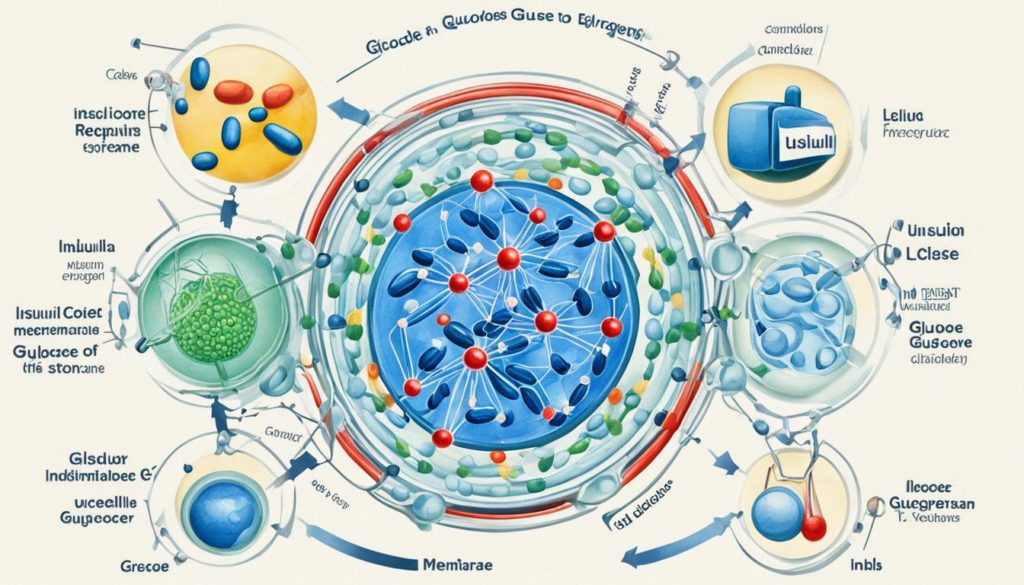Did you know almost 1 in 3 Americans has insulin resistance? This condition greatly raises the chance of getting type 2 diabetes. Dr. Eleanna De Filippis from the Mayo Clinic shares vital insights. We explore what insulin resistance means, its causes, and its effects on health.
Knowing about insulin resistance, how it affects you, and how to handle it is key. It’s all about protecting your health.
Key Takeaways
- Insulin resistance affects nearly 1 out of 3 Americans.
- It is often diagnosed through routine health exams as it may present without symptoms.
- Factors such as genetics, lifestyle, and certain medical conditions contribute to insulin resistance.
- Diagnosis involves blood tests and physical examinations.
- Treatment focuses on lifestyle changes and medications to improve insulin sensitivity.
What is Insulin?
Insulin is a crucial hormone made by the pancreas. It helps control our blood sugar levels, keeping them healthy.

The Role of Insulin in the Body
The insulin hormone role is key to our body’s energy use. When we eat, our body turns food into sugars, like glucose. Insulin helps move this glucose into our cells, giving them energy.
This action is vital for our body to work well and stay healthy.
How Insulin Regulates Blood Sugar Levels
Good blood glucose regulation stops blood sugar from getting too high after eating. The pancreas releases insulin to aid in glucose absorption by cells. This not only lowers blood sugar but also saves some glucose in the liver.
If cells resist insulin, blood sugar stays high, leading to problems.
Now, let’s compare normal insulin function to insulin resistance:
| Aspect | Normal Insulin Function | Insulin Resistance |
|---|---|---|
| Glucose Absorption | Efficient | Impaired |
| Blood Glucose Levels | Within normal range | Elevated |
| Pancreatic Insulin Production | Adequate | Excessive initially, declining over time |
| Long-term Health Impact | Minimal risk | Increased risk of diabetes and cardiovascular issues |
What is Insulin Resistance?
Insulin resistance is when the body’s cells don’t react well to insulin. Insulin helps regulate blood sugar. If cells resist insulin, the pancreas makes more insulin. This can lead to too much insulin in the blood, called hyperinsulinemia.

Definition of Insulin Resistance
Insulin resistance means cells don’t respond well to insulin. So, the pancreas makes more insulin to keep blood sugar normal. This issue can be short-term or long-lasting, and may turn into prediabetes without proper management.
How Insulin Resistance Develops
Several things cause insulin resistance, including genes, lifestyle, and environment. Being overweight, inactive, and eating poorly play big roles. Symptoms include feeling very hungry, tired, and having trouble focusing.
Difference between Insulin Resistance and Diabetes
Understanding the difference between insulin resistance and diabetes is important. Insulin resistance means the body’s response to insulin is not normal. Diabetes happens when blood sugar is high because there’s not enough insulin or it’s not used right. Prediabetes is when blood sugar is high but not high enough to be diabetes. Catching and treating it early can often stop type 2 diabetes from starting.
Knowing how these conditions differ and develop is key to dealing with them. Here’s how they compare:
| Aspect | Insulin Resistance | Diabetes |
|---|---|---|
| Definition | Decreased sensitivity to insulin | High blood glucose levels |
| Insulin Levels | Usually high | Variable: high, low, or normal |
| Reversibility | Potentially reversible with lifestyle changes | Managed but generally not reversible |
Insulin Resistance Symptoms
It’s hard to spot insulin resistance because it might not show clear signs. It’s vital to have regular doctor visits to catch it early. Yet, certain symptoms could suggest you might have insulin resistance.
Common Symptoms of Insulin Resistance
Some people might notice symptoms that hint at insulin resistance. These important symptoms are:
- Fatigue and general tiredness
- Increased hunger and thirst
- Difficulty concentrating, also known as “brain fog”
Physical Signs to Watch For
During a doctor’s check-up, some physical signs might point to insulin resistance. Look for these signs:
- Large waist circumference: Over 40 inches for men and 35 inches for women
- Skin conditions: Acanthosis nigricans and skin tags
- High blood pressure
- Abnormal blood lipid levels
If you are good at spotting these symptoms, you could catch insulin resistance early. Those with diabetes in their family or who notice these signs should get a full health check.
Insulin Resistance Causes
It’s crucial to understand what causes insulin resistance to prevent and manage it. We’ll look into how genetics, lifestyle, and health issues play a part.
Genetic Factors
Genetics is a big factor behind insulin resistance causes. If your family has a history of type 2 diabetes or metabolic syndrome, you might be at risk. Also, ethnicity matters. African Americans, Hispanics, and Native Americans face higher risks, showing how genes and environment interact.
Lifestyle Factors
Your lifestyle choices greatly affect insulin resistance. Not moving enough, sitting too much, and being overweight are key issues. Being heavy, especially around the belly, ups your chances of metabolic syndrome and insulin resistance. Eating too much processed and sweet food also makes things worse.
Medical Conditions Associated with Insulin Resistance
Some health problems make insulin resistance more likely. Disorders like Cushing’s syndrome or Polycystic Ovary Syndrome (PCOS) mess with how your body uses insulin. Some medicines and sleep disorders, like sleep apnea, can also increase the risk. It’s vital to handle these health challenges to control insulin resistance well.
Insulin Resistance Diagnosis
Diagnosing insulin resistance involves a combination of physical examinations and blood tests. These tests help healthcare providers to detect any irregularities that might point towards insulin resistance and related conditions.
Blood Tests for Insulin Resistance
Key tests include the glucose tolerance test and the A1C test. The glucose tolerance test checks how the body processes sugar over time. It offers insights into possible insulin resistance.
Meanwhile, the A1C test measures average blood glucose levels over the past three months. This provides another critical indication.
Another standard procedure is the fasting plasma glucose (FPG) test. It measures blood sugar levels after an overnight fast. High results in these tests suggest potential insulin resistance. This calls for further medical attention.
“The oral glucose tolerance test (OGTT) is crucial in identifying how well insulin manages glucose levels, which is vital for assessing insulin resistance.”
| Test Name | Purpose | Frequency |
|---|---|---|
| Glucose Tolerance Test | Evaluates body’s sugar processing | As prescribed |
| A1C Test | Measures average glucose over 3 months | Every 3-6 months |
| Fasting Plasma Glucose Test | Measures fasting blood sugar levels | Annually or more as needed |
Physical Examination by a Doctor
A thorough physical exam by a doctor is critical in the insulin resistance diagnosis. Doctors look for symptoms like high blood pressure, skin changes, and central obesity. These are common indicators.
They combine these physical findings with blood test results. This forms a full approach to diagnosing insulin resistance.
Using these methods, healthcare providers can confirm an insulin resistance diagnosis. They guide patients towards effective treatment plans and lifestyle changes to manage their condition.
Insulin Resistance Explanation
Knowing about insulin resistance is key to good health and stopping bad diseases. This part explains why insulin sometimes doesn’t work right. It also talks about the health consequences if you ignore it.
Why Insulin Stops Working Effectively
Insulin resistance happens when cells in muscles, fat, and liver don’t react well to insulin. This is often because of too much visceral fat and inflammation. As a result, blood sugar levels go up. This is because insulin can’t move glucose into cells well.
The pancreas then makes more insulin, causing hyperinsulinemia. If not checked, this could lead to prediabetes and then type 2 diabetes. For more info, check out this detailed overview by the NIDDK.
Consequences of Ignoring Insulin Resistance
Not paying attention to insulin resistance can bring lots of health consequences. If you don’t manage your blood sugar, you could get heart disease, have a stroke, or get metabolic syndrome. These big health problems need early action and smart management to avoid worse issues.
Making lifestyle changes, like losing weight and more exercise, is crucial. It can flip insulin resistance and keep glucose levels normal. This helps avoid bad outcomes.
| Health Risk | Impact of Insulin Resistance |
|---|---|
| Heart Disease | Increased risk due to poor blood sugar management |
| Stroke | Higher incidence linked to unmanaged blood glucose levels |
| Metabolic Syndrome | A constellation of conditions exacerbated by insulin resistance |
Insulin Resistance Treatment
Fighting insulin resistance often means adopting lifestyle changes and possibly using medications. This approach doesn’t just help manage blood sugar. It also works to stop Type 2 diabetes from developing.
Medications Used
Metformin is a go-to drug for insulin resistance. It lowers glucose made by the liver and boosts insulin sensitivity. It’s great at delaying Type 2 diabetes in people at high risk.
The Cleveland Clinic suggests a whole approach is best for managing insulin resistance. This includes medicine and lifestyle changes for top results.
Lifestyle Modifications
Lifestyle changes are key in tackling insulin resistance, alongside medicines. Things like staying active, eating well, and keeping a healthy weight matter a lot. A study showed that dropping 5-7% of body weight can cut diabetes risk in those at risk.
- Physical Activity: Regular workouts make the body better at using glucose and increase insulin sensitivity.
- Balanced Diet: Eating foods like whole grains, lean meats, and veggies helps with weight and improves insulin use.
- Weight Management: Keeping a healthy weight is crucial for lowering diabetes risk and managing insulin resistance.
Using medications like metformin with lifestyle shifts can help control insulin resistance. It also lowers the health dangers linked with it.
Insulin Resistance Diet
To manage insulin resistance well, you need a smart diet. Choosing the right foods helps control blood sugar and boosts health. Eating right can make big changes and even reverse insulin resistance.
Foods to Include
An insulin resistance diet means eating lots of fiber, healthy fats, and lean proteins. Go for veggies like spinach, broccoli, and bell peppers. Nuts, beans, and legumes keep blood sugar steady. Berries, apples, and lean meats like chicken, turkey, and fish are great too.
Foods to Avoid
But, some foods can make insulin resistance worse. Try to eat less sugar and processed stuff. Cookies, candies, and sugary drinks can spike your insulin. Cut back on white bread and pasta to control insulin better. Avoiding these helps you stick to a good insulin resistance diet.
Importance of a Balanced Diet
Eating healthy is key to managing insulin resistance. A balanced diet with the right mix of carbs, proteins, and fats lowers blood sugar risks. It keeps you well and supports long-term health. Pairing your diet with being active builds a strong health foundation.
FAQ
What is insulin resistance?
Insulin resistance is when your body’s cells don’t react right to insulin. This leads to high blood sugar levels. Often, there are no clear signs. It can get worse, turning into prediabetes or type 2 diabetes if not treated.
What are common symptoms of insulin resistance?
There might not be clear symptoms of insulin resistance. However, some signs include having a large waist, certain skin conditions, high blood pressure, and unusual blood fat levels.
How does insulin function in the body?
Insulin is a hormone from the pancreas. It helps control blood sugar levels. Insulin allows sugars from food to be used by cells for energy, which keeps blood sugar normal.
What factors contribute to developing insulin resistance?
Genetic factors, lifestyle choices like not being active, and obesity play a role. Conditions like PCOS and Cushing’s syndrome, some medications, and lack of sleep also contribute.
How is insulin resistance diagnosed?
Doctors use blood tests like the FPG, OGTT, and A1C tests. They also look for physical signs such as a large waist and abnormal blood sugar or cholesterol.
Why does insulin stop working effectively in insulin resistance?
Cells in muscles, fat, and the liver won’t respond well to insulin due to excessive fat and inflammation. This makes the pancreas work harder, leading to high blood sugar and health problems.
What are the consequences of ignoring insulin resistance?
Not dealing with insulin resistance can cause heart disease, stroke, and metabolic syndrome. It’s important to catch and manage it early.
What are the treatment options for insulin resistance?
Treating insulin resistance usually involves changes in lifestyle like losing weight and exercising more. Sometimes, doctors suggest medicines like Metformin. This can make your body respond better to insulin and help prevent diabetes.
What dietary changes can help manage insulin resistance?
Eating fruits, vegetables, nuts, beans, and lean proteins helps. Avoid foods high in sugar and processed items. Eating well and staying active are key to better health and handling insulin resistance.


